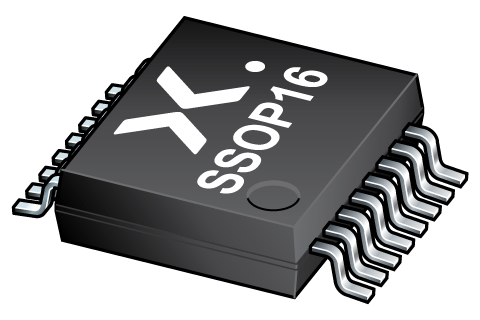
Register once, drag and drop ECAD models into your CAD tool and speed up your design.
Click here for more information74HC160DB
Presettable synchronous BCD decade counter; asynchronous reset
The 74HC/HCT160 are high-speed Si-gate CMOS devices and are pin compatible with low power Schottky TTL (LSTTL). They are specified in compliance with JEDEC standard no. 7A.
The 74HC/HCT160 are synchronous presettable decade counters which feature an internal look-ahead carry and can be used for high-speed counting.
Synchronous operation is provided by having all flip-flops clocked simultaneously on the positive-going edge of the clock (CP).
The outputs (Q0 to Q3) of the counters may be preset to a HIGH or LOW level. A LOW level at the parallel enable input (PE) disables the counting action and causes the data at the data inputs (D0 to D3) to be loaded into the counter on the positive-going edge of the clock (providing that the set-up and hold time requirements for PE are met). Preset takes place regardless of the levels at count enable inputs (CEP and CET).
A LOW level at the master reset input (MR) sets all four outputs of the flip-flops (Q0 to Q3) to LOW level regardless of the levels at CP, PE, CET and CEP inputs (thus providing an asynchronous clear function).
The look-ahead carry simplifies serial cascading of the counters. Both count enable inputs (CEP and CET) must be HIGH to count. The CET input is fed forward to enable the terminal count output (TC). The TC output thus enabled will produce a HIGH output pulse of a duration approximately equal to a HIGH level output of Q0. This pulse can be used to enable the next cascaded stage.
The maximum clock frequency for the cascaded counters is determined by the CP to TC propagation delay and CEP to CP set-up time, according to the following formula:
fmax= (1) / (tP (max)( CP to TC) + tSU(CEP to CP) )
Alternatives
Features and benefits
Synchronous counting and loading
Two count enable inputs for n-bit cascading
Positive-edge triggered clock
Asynchronous reset
Output capability: standard
ICC category: MSI
Applications
Television sets
Home-sound sets
Multimedia systems
All mains fed audio systems
Car audio (boosters).
Parametrics
| Type number | Package name |
|---|---|
| 74HC160DB | SSOP16 |
Package
All type numbers in the table below are discontinued.
| Type number | Orderable part number, (Ordering code (12NC)) | Status | Marking | Package | Package information | Reflow-/Wave soldering | Packing |
|---|---|---|---|---|---|---|---|
| 74HC160DB | 74HC160DB,112 (935189680112) |
Obsolete | HC160 Standard Procedure Standard Procedure |

SSOP16 (SOT338-1) |
SOT338-1 |
SSOP-TSSOP-VSO-REFLOW
SSOP-TSSOP-VSO-WAVE |
Not available |
| 74HC160DB,118 (935189680118) |
Obsolete | HC160 Standard Procedure Standard Procedure | Not available |
Environmental information
All type numbers in the table below are discontinued.
| Type number | Orderable part number | Chemical content | RoHS | RHF-indicator |
|---|---|---|---|---|
| 74HC160DB | 74HC160DB,112 | 74HC160DB |
|
|
| 74HC160DB | 74HC160DB,118 | 74HC160DB |
|
|
Documentation (8)
| File name | Title | Type | Date |
|---|---|---|---|
| 74HC160 | Presettable synchronous BCD decade counter; asynchronous reset | Data sheet | 2019-03-29 |
| AN11044 | Pin FMEA 74HC/74HCT family | Application note | 2019-01-09 |
| Nexperia_package_poster | Nexperia package poster | Leaflet | 2020-05-15 |
| SSOP16_SOT338-1_mk | plastic, shrink small outline package; 16 leads; 0.65 mm pitch; 6.2 mm x 5.3 mm x 2 mm body | Marcom graphics | 2017-01-28 |
| SOT338-1 | plastic, shrink small outline package; 16 leads; 0.65 mm pitch; 6.2 mm x 5.3 mm x 2 mm body | Package information | 2022-06-20 |
| SSOP-TSSOP-VSO-REFLOW | Footprint for reflow soldering | Reflow soldering | 2009-10-08 |
| HCT_USER_GUIDE | HC/T User Guide | User manual | 1997-10-31 |
| SSOP-TSSOP-VSO-WAVE | Footprint for wave soldering | Wave soldering | 2009-10-08 |
Support
If you are in need of design/technical support, let us know and fill in the answer form we'll get back to you shortly.
Longevity
The Nexperia Longevity Program is aimed to provide our customers information from time to time about the expected time that our products can be ordered. The NLP is reviewed and updated regularly by our Executive Management Team. View our longevity program here.
Models
No documents available
How does it work?
The interactive datasheets are based on the Nexperia MOSFET precision electrothermal models. With our interactive datasheets you can simply specify your own conditions interactively. Start by changing the values of the conditions. You can do this by using the sliders in the condition fields. By dragging the sliders you will see how the MOSFET will perform at the new conditions set.